Home Donate New Search Gallery How-To Books Links Workshops About Contact
Nikon D40, D5000, D300 and D3 High ISO Comparison
© 2009 KenRockwell.com. All rights reserved.
Intro Analysis Summary Technik
ISO 100 200 400 800 1,600 3,200 6,400 12,800 25,600
It helps me keep adding to this site when you use these links to Adorama, Amazon, B&H, Calumet, Ritz, J&R and eBay to get your goodies. Thanks! Ken.
May 2009 Nikon D40 Review Nikon D5000 Review Nikon D300 Review Nikon D3 Review More Nikon Reviews
Introduction top
This is the full image from which I will show greatly enlarged crops:
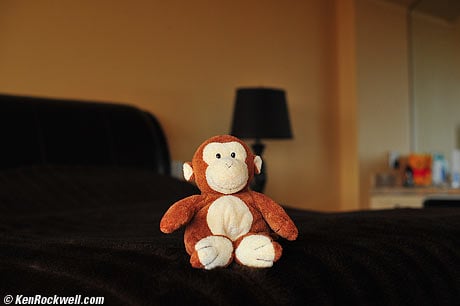
Self Portrait. Light Value 7.
If you printed the entire image the same size as each of the greatly magnified crops below, each would print at 42 x 28" (100 x 70cm).
This image was carefully contrived to show not just noise, visible on the out-of-focus background that transitions softly from dark to light in critical skin tones; the live monkey lets us see how much detail is retained after each camera tries to hide noise by smudging it over with its own noise reduction (NR).
Don't look at the eye or the sharp white-brown transition, since NR is smart enough to leave obvious edges sharp. Look at the in-focus fur near that transition, and you'll see the lesser cameras lose all the detail in the fur.
The texture in the fur is crucial: any camera can have more or less noise if it removes more or less texture along with it. The background noise level means nothing if there is no detail left.
You always can use more NR software later to reduce background noise, but never can get back detail if the camera smudged it over.
Click any image to get to a full review of that camera.
The Nikon D700 and D3X have performance similar to or better than the D3. See my D3X to D3 comparison and D700 to D3 comparisons. If you want to see how the D3X or D700 stack up, just follow along the D3 column.
As tested earlier, the D90 is most likely very similar to the D5000.
I also have numerous other comparisons to the D40 and D300, so cruise their reviews and you'll be able to compare other models of camera. If I try to include more than four at a time, it gets cumbersome to present.
Click the ISO 100 200 400 800 1,600 3,200 6,400 12,800 25,600 anchors to zip around the page to compare each camera at different speeds.
ISO 100 ISO 100 200 400 800 1,600 3,200 6,400 12,800 25,600 top
D40 doesn't go to ISO 100. |
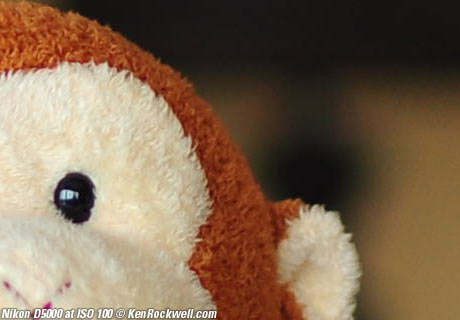 |
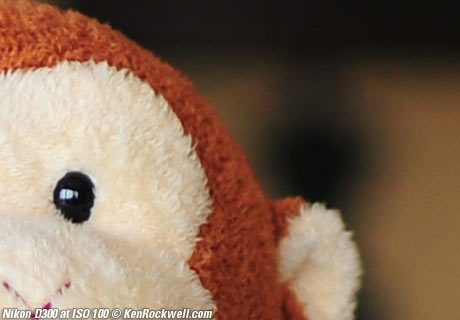 |
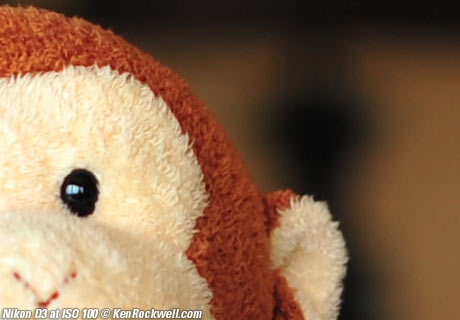 |
The D3 picks up contrast at ISO 100. Looking at the soft background, even at ISO 100 the D3 is cleaner.
ISO 200 ISO 100 200 400 800 1,600 3,200 6,400 12,800 25,600 top
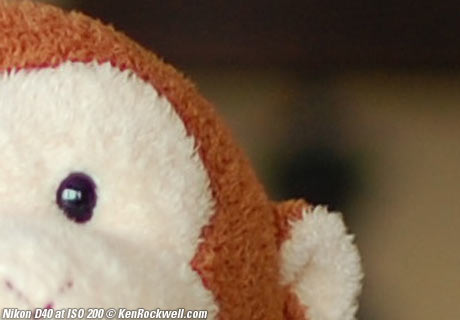 |
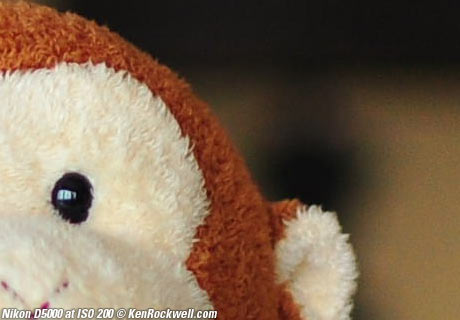 |
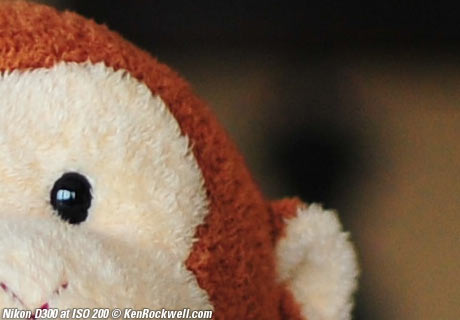 |
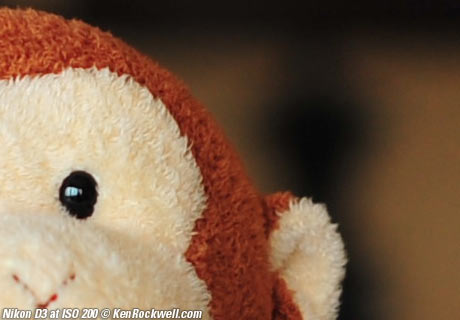 |
The D5000 and D300 have visible noise in actual use at their defaults of ISO 200. The ADR system emphasizes noise as it lightens shadows (increases ISO) for contrasty subjects.
The D3 has so little noise that its ADR system doesn't make it look any worse.
Don't turn off ADR! It makes huge improvements to all images; the noise is irrelevant if you have an image with blocked-up shadows or highlights with ADR prevents.
ISO 400 ISO 100 200 400 800 1,600 3,200 6,400 12,800 25,600 top
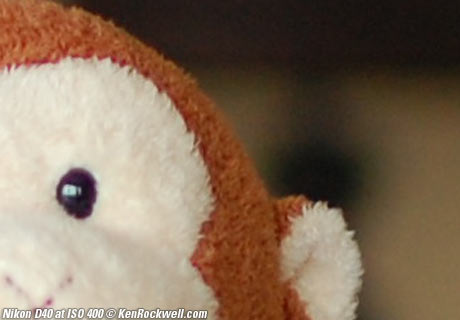 |
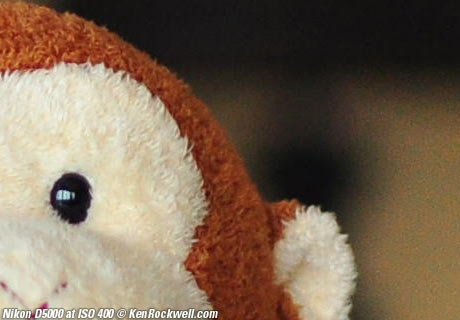 |
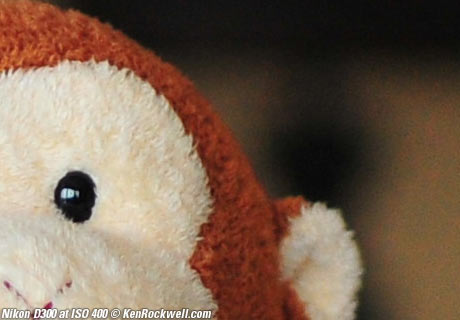 |
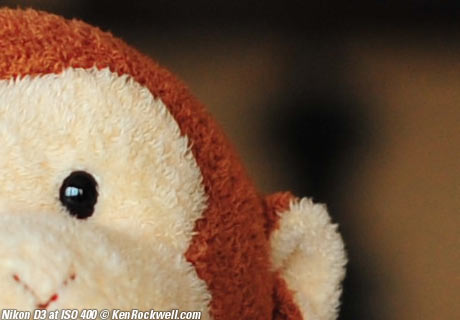 |
The D5000 is the noisiest, but look at the fur: the D300 has cheated by making everything softer. I prefer the D5000 because it retains much more detail at ISO 400. If I want softer, I can do it later in software, but I never can bring back detail later.
Of course the D3 looks clean and sharp, that's what you expect from FX.
The D40, sitting quietly in the upper left corner, has less noise than the D300 or D5000. This is because it's got big, fat light-sucking pixels and no ADR. It also has less sharpness at this magnification because of its lower resolution (6MP vs. 12MP).
ISO 800 ISO 100 200 400 800 1,600 3,200 6,400 12,800 25,600 top
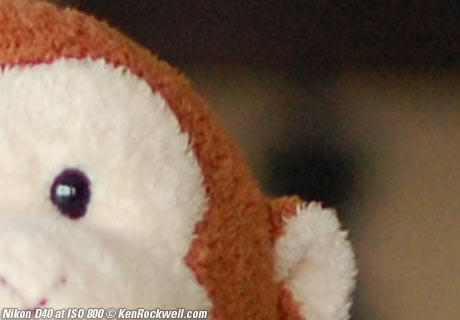 |
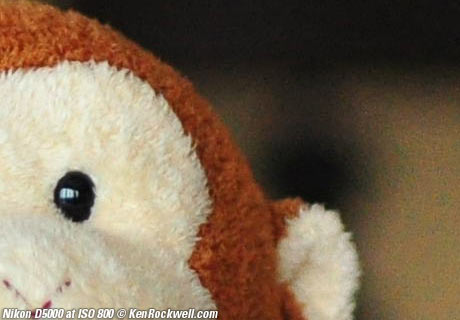 |
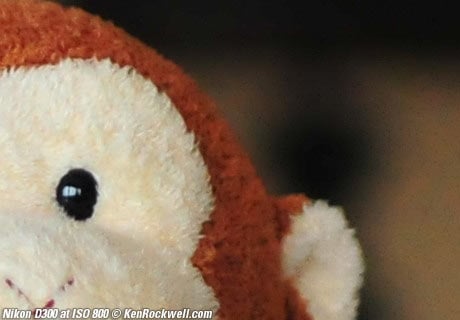 |
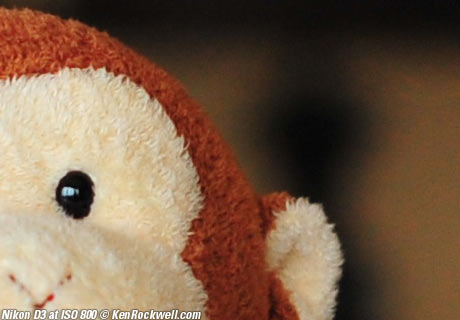 |
I see about the same comparisons as at ISO 400.
ISO 1,600 ISO 100 200 400 800 1,600 3,200 6,400 12,800 25,600 top
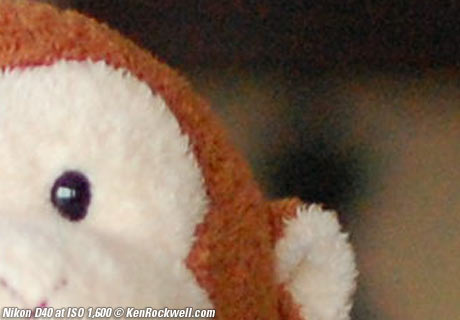 |
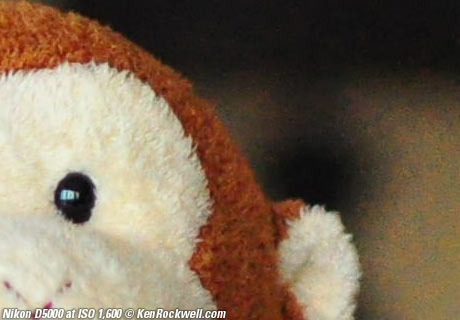 |
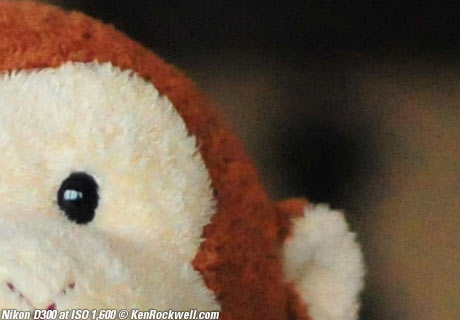 |
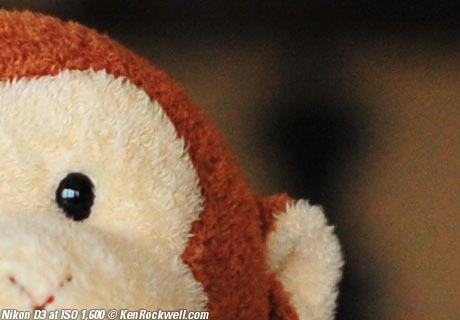 |
At ISO 1,600 things look pretty similar. I had to go back to the original images to compare.
The D40 is softer overall from its lower resolution. Its noise level is about the same as the others.
The D300 is the softest. Its smoothed over all the texture in the fur. As I've reviewed before, the D300 uses way too much noise reduction to smooth over noise at the expense of sharpness. Nikon did this to pimp the ISO spec of the D300 to sell more cameras, not to improve actual image quality.
The D3 and D5000 have similar levels of detail, much better than the D300, while the D3 is a bit cleaner than any of the others.
ISO 3,200 ISO 100 200 400 800 1,600 3,200 6,400 12,800 25,600 top
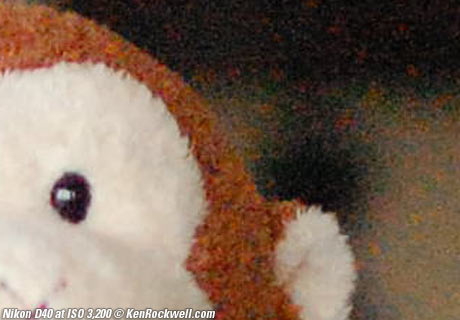 |
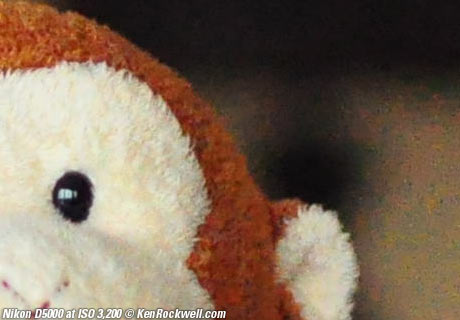 |
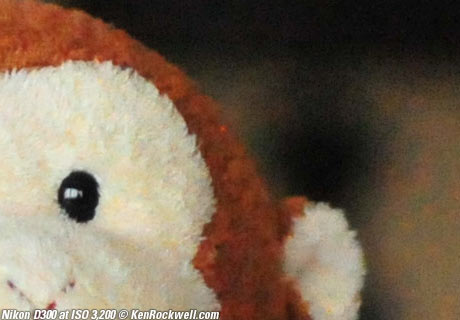 |
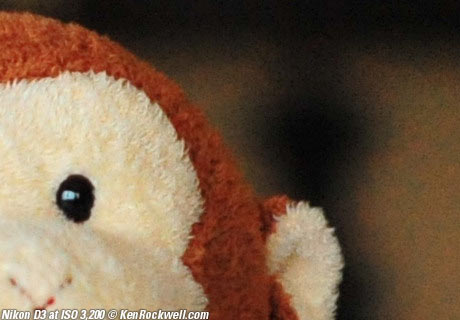 |
The D40 loses it at ISO 3,200. On the D40, ISO 3,200 is a HI+1 setting. It gets really grainy. It comes in last here.
The D300 is second to last. It's reasonably clean, but that's because it's also removed all the texture along with the noise. The brown fur looks just like old pizza, not fur.
The D5000 is much sharper than the D300, a close second place to the D3.
The D3 is sharper and much cleaner than the D5000, as expected.
ISO 6,400 ISO 100 200 400 800 1,600 3,200 6,400 12,800 25,600 top
D40 doesn't go to ISO 6,400 unless pushed. |
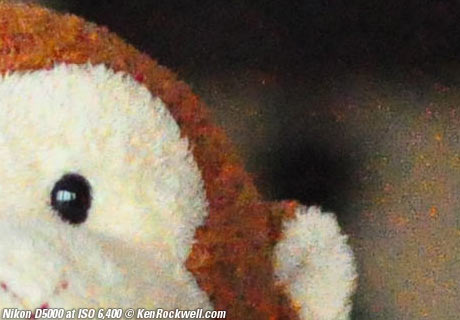 |
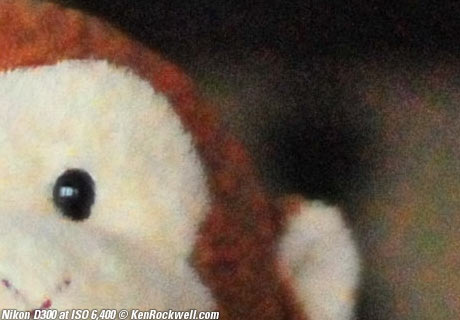 |
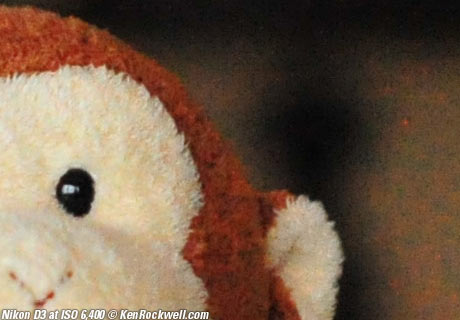 |
The D300 is awful. Its noise reduction has fuzzed over everything. That's not a defocus problem you're seeing, its the D300's NR.
The D3 is cleaner than the D5000. The D5000 at ISO 1,600 - 3,200 looks about the same as the D3 at ISO 6,400. Both the D5000 and D3 have a few red hot pixels.
ISO 12,800 ISO 100 200 400 800 1,600 3,200 6,400 12,800 25,600 top
 |
 |
 |
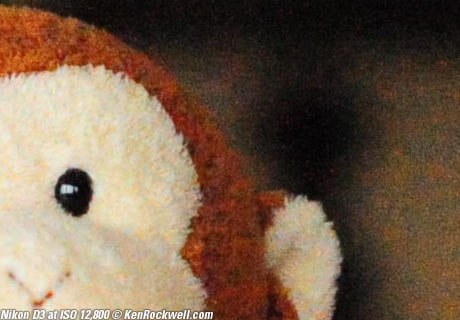 |
D40, D300 and D5000 don't go to ISO 12,800 unless pushed.
ISO 25,600 ISO 100 200 400 800 1,600 3,200 6,400 12,800 25,600 top
 |
 |
 |
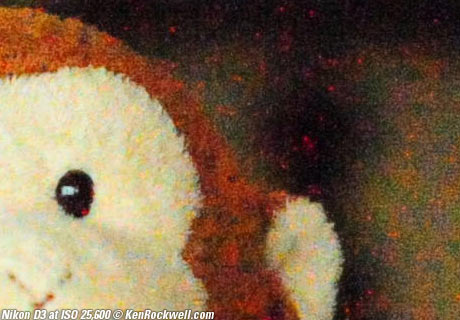 |
D40, D300 and D5000 don't go to ISO 25,600, or even close.
Analysis top
Follow your own eyes, but I have the advantage of having seen all these images on a 30" monitor and not just these smaller clips that fit your browser window.
The D40 is competent, and as clean as the others at lower ISOs.
The D300 uses too much NR. Its images get very soft at higher ISOs and print sizes. Yes, if you shoot a D300 you could screw with the NR settings or raw files, I didn't play with those here. If I tried to include every possible permutation for each camera, I'd never get anything tested.
The D5000 is quite good. I have not compared it directly to the D90 which is also superior to the D300, but for low-light, the D5000 is certainly better than the D300. I didn't test for it here, but the D5000 crushes blacks (makes them darker) at higher ISOs, making for uglier pictures.
As expected, the D3 is the king at high ISOs, as is the D700 and D3X.
When you take away the effects of the camera's own noise reduction, the only thing that really matters is sensor size. The D3 has a sensor over twice the size of the other cameras.
Summary top
If low-light performance is important to you, far more important than your choice of camera is your choice of lens.
The $200 Nikon 35mm f/1.8 should be in every DX shooter's bag, and the 50mm f/1.4 AF-S needs to be in every FX shooter's bag.
Any f/1.8 lens is four times more sensitive to low light than an f/3.5 zoom, and an f/1.4 lens is four times more light sensitive than any f/2.8 pro zoom.
Buying a $200 lens and a $450 D40 is a better solution than the D5000 or D300 and a $500 f/3.5 or $1,500 f/2.8 zoom.
With the right lens, I can shoot handheld in full moonlight at ISO 6,400.
Camera sensor size is far more important to low-light ability than camera model within the same sensor size.
Most DX cameras are about the same; differing more in the amount of noise reduction they apply than any fundamental difference between cameras.
Likewise, all compact cameras, especially the Canon G10 and Nikon P6000, are horribly bad at high ISOs, and FX cameras are spectacularly good.
Technik top
Each shot was made with a 35mm f/1.8 lens at f/2 in aperture-priority exposure mode. The light level was LV7, meaning ISO 200 shots were made at f/2 and 1/60. You can calculate the rest if you care.
The D3 shots were made with a 50mm f/1.4 AF-S lens at f/2.8 to give the same depth-of-field and angle of view as the other images.
All cameras have the same resolution and the crops are all 1:1 from 100% images, except from the lower-resolution D40, whose images were resized to the same size before cropping (140% magnification, Photoshop CS4 Bicubic). This makes all images the same size on-screen, and means we're looking at what we'd see if we hung an exhibition with the same size prints from each camera.
The Gen 2 cameras (D5000, D300 and D3) were set to sharpening = 5, VIVID and +3 Saturation Picture Control, and ADR was set to NORMAL on the D3 and D300 and AUTO on the D5000.
The D40 is a Gen 1 camera, and was set to color mode IIIa and + Saturation. Sharpening was left at its default of AUTO and Tone Compensation at its default of AUTO.
These images were taken directly from each camera, as processed by each camera as a JPG. It makes no sense to try to compare raw files, since raw files can't be interpreted until processed by external software. If you try to compare raw files, you wind up chasing your own tail as each software package handles sharpening and noise reduction differently.
I'm interested in the total performance of each camera. If you shoot raw, you'll have to spend a couple of days redoing this test yourself using whichever software package (and version) you prefer.
These results show the actual results from each camera's complete image processing chain.
PLUG top
I support my growing family through this website, as crazy as it might seem.
If you find this as helpful as a book you might have had to buy or a workshop you may have had to take, feel free to help me continue helping everyone.
If you've gotten your gear through one of my links or helped otherwise, you're family. It's great people like you who allow me to keep adding to this site full-time. Thanks!
If you haven't helped yet, please do, and consider helping me with a gift of $5.00.
The biggest help is to use these links to Adorama, Amazon, B&H, Calumet, Ritz and J&R when you get your goodies. It costs you nothing and is a huge help. These places have the best prices and service, which is why I've used them since before this website existed. I recommend them all personally.
Thanks for reading!
Ken
Home Donate New Search Gallery How-To Books Links Workshops About Contact
